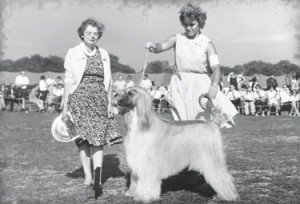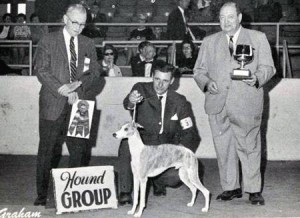From The CC Vault: Past & Present with Jane & Bob: How Has Our Sport Changed?
by Francine Reisman
Originally published: February 2014
 As with many “dog show people”, much of my time is taken up by long discussions about dogs and dog shows. The popular topic among my peers is the seemingly end of our sport as we knew it. There have been great changes in the past 20 some-odd years, with seemingly more on the way. I decided to ask long-time, established and well-respected all breed handlers for their feelings about these changes. The first name that came to me was Forsyth, Jane and Bob. Growing up in New York, going to shows in this area, Bob and Jane were the top handlers, the pinnacle of their profession. I don’t think anyone questioned their number one spot. Years later I realized that the success they had was earned by their professionalism. I knew someone who worked for them so I had access to some inside information. Their kennel, Greyarlen, was spotless. Each dog was well cared for both physically and mentally. It was the same with ‘The Bluebird’ (the Forsyth’s retired school bus which housed the dogs while on the road). It appeared that the bus was never left unattended. Assistants were there getting dogs ready for the ring or getting them ready for the next leg of the weekend. From what I learned, Mondays at the kennels was spent sending out catalog pages to the owners of all the dogs that were shown that weekend and making phone calls to let the owners know how their dogs did. One of the biggest gripes against professional handlers, at that time, was that the owners never heard from the handlers and had to hunt them down to get information. Not so with the Forsyths.
As with many “dog show people”, much of my time is taken up by long discussions about dogs and dog shows. The popular topic among my peers is the seemingly end of our sport as we knew it. There have been great changes in the past 20 some-odd years, with seemingly more on the way. I decided to ask long-time, established and well-respected all breed handlers for their feelings about these changes. The first name that came to me was Forsyth, Jane and Bob. Growing up in New York, going to shows in this area, Bob and Jane were the top handlers, the pinnacle of their profession. I don’t think anyone questioned their number one spot. Years later I realized that the success they had was earned by their professionalism. I knew someone who worked for them so I had access to some inside information. Their kennel, Greyarlen, was spotless. Each dog was well cared for both physically and mentally. It was the same with ‘The Bluebird’ (the Forsyth’s retired school bus which housed the dogs while on the road). It appeared that the bus was never left unattended. Assistants were there getting dogs ready for the ring or getting them ready for the next leg of the weekend. From what I learned, Mondays at the kennels was spent sending out catalog pages to the owners of all the dogs that were shown that weekend and making phone calls to let the owners know how their dogs did. One of the biggest gripes against professional handlers, at that time, was that the owners never heard from the handlers and had to hunt them down to get information. Not so with the Forsyths.
 Luckily, I was sitting right across the aisle from Jane at the Kennel Club of Philadelphia dog show recently; she was waiting to judge best in show. I found my mostly absent courage and walked over to Jane and asked her if she would consider answering a few questions regarding her thoughts on the state of dog shows today as opposed to shows from the ‘60s and ‘70s. Her immediate answer was yes! She then instructed me to send the questions to Bob as he would make sure they were answered. Ever the professional!
Luckily, I was sitting right across the aisle from Jane at the Kennel Club of Philadelphia dog show recently; she was waiting to judge best in show. I found my mostly absent courage and walked over to Jane and asked her if she would consider answering a few questions regarding her thoughts on the state of dog shows today as opposed to shows from the ‘60s and ‘70s. Her immediate answer was yes! She then instructed me to send the questions to Bob as he would make sure they were answered. Ever the professional!
Following are the questions and the Forsyth’s answers. I thank them both for taking the time to share their thoughts about our sport today.
It is obvious that entries are down throughout the U.S. What do you think is the cause? Why did people in the past stay in the sport as long as they did as opposed to the “Five Year Wonders” of today? Do you think exhibitors had a more even playing field in the past? If yes, why is that?
There are so many reasons entries are down it is difficult to cover them all, perhaps the largest being the loss of the large breeders that were more interested in promoting their breed rather than winning. Expense is also a factor, travel, entry fees, veterinary fees, it goes on and on. We are also facing a difficult job with bringing young people into the sport. We also believe the AKC could be more helpful if they would be more aggressive in combating organizations that are trying to eliminate breeders and the purebred dog. As to the playing field, its the same now as in the past; handlers will always be there. Owner-handlers must learn to do the job with their dogs. We notice the ones that do are well up in ratings, some at the top. In the past, several have taken the top spot at prestigious shows such as Westminster. Of course, professional handlers have an edge due to the fact they may have several dogs from which to select.
Did exhibitors and handlers travel the way people do today? Was flying dogs around the country an important part of the dog game? Why do you think people take dogs around the country as they do now?
No one traveled very far until the ratings systems became popular. Upon occasion, some would travel to some of the larger shows but as a rule most showed in their own area. In the Northeast, many would go to Florida during January as there were no shows at that time in the area. Nowadays, Friday a dog is in the East, Saturday in the West and Sunday back East, all due to ratings. In the ‘50s ‘60s and ‘70s it was rare to find a dog from the East or Mid-west competing in the East except, possibly, at the larger shows.
How has the demise of the big kennels affected the sport today? Where do the top winning dogs come from now?
Large kennels are, of course, a thing of the past but they were very serious about their breeding program, and able to produce better than average animals year after year. Their aim was to improve the breed, not about winning, though the latter was not unwelcome. Many of the top winners of today can be traced back to those kennels of the past. We still have smaller breeders that are producing outstanding stock, but overall they lack consistency. Imports have always played a large part in our breeding programs, and many have been outstanding in the show ring as well as in their breeding programs.
How do you feel about the 4- and 5-day “weekends” of shows? What was the longest circuit of shows back in the ‘60s and ‘70s. Do you think the level of conditioning today is better or worse than in earlier days? What about grooming?
More than three or four shows a weekend is more than any dog should have to endure in our opinion. To keep a dog in proper physical and mental condition, rest and exercise are of the utmost importance, living in a crate five or six days a week is not going to do it. The larger breeds, of course, are the most affected but it will harm all breeds over time. Coat conditioning is about the same although it has improved in some breeds such as Poodles of which we handled quite a few. The growing of hair was easy but we did not know how to sculpture as they do today. Must say it’s a vast improvement. Most of the shows we attended were in the Northeast, which were two or three just about every weekend except January and February when there were none. However, we did do the Florida circuit from time to time and were fixtures on the Tar Heel, both consisted of twelve shows or so; the New England circuit was also a must. We always found time for a swim or a round of golf. As a rule, these circuits were broken up for a day or two which was spent washing and grooming.
What do you think has improved in dog shows and what has declined?
On the plus side, sites have improved in most cases. Benching is pretty much a thing of the past. Well-trained Field Reps are a blessing. On the down side, camaraderie has declined somewhat. The gatherings where one could learn from the best seem to have gone by the wayside. All breed shows getting clubs back in their own area would be a great thing.
Do you feel that the AKC’s involvement has changed the face of dog shows?
Yes. We think the AKC has changed dog shows, some for the good, others not so good. They, however, must look to the future if the breeding of purebred dogs and dog shows are going to survive. It seems we are always playing catch up instead of being the frontrunner.
Short URL: http://caninechronicle.com/?p=250451
Comments are closed












